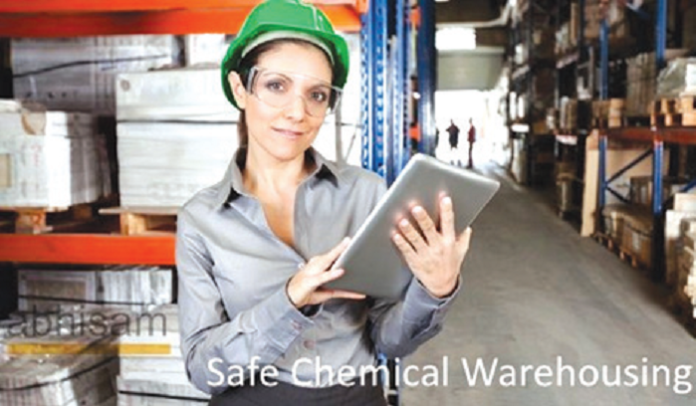Abstract
The business of a company depends upon the efficiency of manufacturing, supply chain and marketing and commercials. Supply chain efficiency depends on the effectiveness of logistics, which includes warehouse operations. Warehouse operations can be effective provided warehouse design, layout, infrastructure, processes, staff and safety norms, transportation are appropriate to the requirements and also safe.
Chemical Warehouse Safety is to be ensured, so that safety is always maintained, while storing and handling chemicals, many of which are hazardous. For accomplishing the required requirements, these functions should satisfy the desired parameters. Above all, corresponding national legal requirements have to be met. The relevant international norms should be met as per agreements. In the case of warehouses that store chemicals and/or materials that may be hazardous to humans, plants, animals or the environment, it is extremely important to have a design that ensures safety.
Warehouse Design Factors
The main objective of warehousing should be aligned with company’s business strategy.
The warehouse design should aim at desired utility of space, orderly layout, safe product storage according to hazard, safe warehouse operations, emergency handling, and security of warehouse.
The most important part of the design is the concept of inherently safe design, such as creating a stable building constructed with built in protection. This should cover design of walls, floor, roof, ventilation, retention water catchment basins, fire walls, fire doors, etc. The layout should take care of product storage, loading/ unloading, parking, utility, safety equipment, welfare facilities.
Product storage plays an important role, as product characteristics may have health, safety and environmental hazards. Hazardous chemicals improperly stored and improperly handled in the warehouse, can cause fire or explosion resulting in injury of personnel at site, as well as in the neighbouring areas and loss of property inside the warehouse and outside. An understanding of hazards and associated risks will help in selecting better control measures. The potential safety and health and environmental impacts can be prevented by implementing control measures in the early design stage. The Globally harmonised system (GHS) hazard class can guide hazardous product storage. GHS also guides labelling and hazard communication which helps in identifying hazards and also helps in handling measures.
Warehouse Operations
Once we have a good warehouse design, then what is the next important factor to consider? It is safe warehousing operation. The warehouse management should cover all operations, activities and defined procedures should be laid down for operations and activities. These various activities include receiving, verifying, inventory and dispatches as the main ones in addition to auxiliary ones. There will be operations of loading and unloading involving manual handling and machine handling, which should be carried out safely without having accidents.
HSE (Health, Safety and Environmental) requirements like medical aid, Personal Protective Equipment (PPE), fire suppression (such as fire extinguishers) should be met. Medical aids can be used to deliver immediate treatment at site. Since hazardous substances are handled, appropriate PPE like helmets, safety goggles, safety shoes, face shields, body overalls/aprons are required. Fire fighting equipment like extinguishers, sprinklers should be available for mitigation of emergency. Good housekeeping will prevent potential accidents.
Product safety data sheets (SDS) as per GHS should be available for quick reference in case of emergency. Also TREM cards should accompany each consignment so that driver can act accordingly as a first measure immediately in case of emergency and further rescue team attending on emergency can take actions accordingly.
Shipping standard markings should be followed before dispatching. These will include names and symbols as per the GHS. For the efficient working of warehouse, organisational procedures should be documented, implemented and reviewed periodically and should be available at the work place. Operating procedures/Work Instructions should be available for warehouse activities like – selection of warehouse, evaluation of warehouse for renewing contracts, receiving, storing, dispatch, market returns and damaged and non-usable products, unloading and loading, maintenance and inspection.
Warehouse Safety & Security-Emergency Procedures
For large warehouses, audible alarms using smoke or heat sensors may be installed to alert the personnel in the warehouse to be ready for any emergency such as a fire. Sprinkler systems normally are alarm activated. Periodic trials of alarms and maintenance should be carried out to ensure that these work when needed. For very big warehouses, manual audible alarms may be installed at specific distances/every big compartment to alert the personnel in case of emergency. Fire extinguishers of course, are mandatory as well as properly designed fire hydrant systems.
An Emergency procedure should be available at the warehouse site to mitigate emergency. Personnel should be trained to use the fire-fighting equipment. Emergency drills should be carried out and practiced. Clean up after emergency should be collected safely and disposed-off for landfill or incineration as the case may be.
Just see what happened at the Tianjin Warehouse explosion recently in China. Apparently there was no information (or at best imprecise information), about the kind of hazardous materials stored in the warehouse, as also their quantities and the emergency procedures were unclear. This led to firefighters dousing the initial fires with water jets that released even more toxic chemicals leading to an accident much larger.
Also the security of warehouse is a major concern, especially for the chemical storage warehouses. Products may be expensive but also hazardous. Thus there could pose a danger to the community and environment, if misused by thieves. Proper lighting, fencing and intruder alarm systems should deter potential thieves. The cost of security is miniscule as compared to the environmental impact of theft of materials and subsequent misuse.
Conclusion
Warehousing is an important part of the supply chain and warehouse safety is therefore also important. In the case of warehouses that store hazardous chemicals and similar materials, it is even more important to have a good warehouse design that is inherently safe, is secured from thieves and other malicious actors, so that it continues to add value to the organization without any adverse impacts to the environment.
Note: The best way to learn about Safe Chemical Warehousing is by taking our e-learning course on the subject. You can view the free demo too, before buying it. You also get a free certification with an electronic badge, after you take the course and pass the exam.
Courtesy: www.abhisam.com/chemical-warehouse-design-for-safety

































